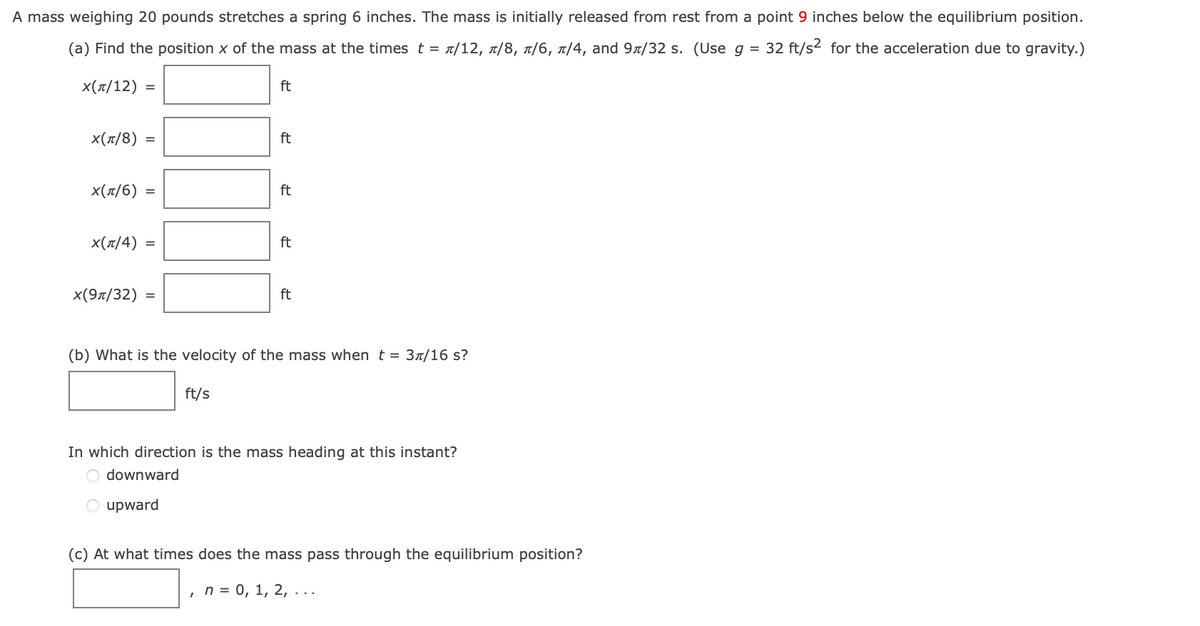A mass weighing 20 pounds stretches a spring 6 inches. The mass is initially released from rest from a point 9 inches below the equilibrium position. (a) Find the position x of the mass at the times t = /12, /8, /6, /4, and 9/32 s. (Use g = 32 ft/s² for the acceleration due to gravity.) x(x/12) = X(π/8)= X(π/6)= X(π/4)= x(9x/32): = ft ft/s ft ft ft ft (b) What is the velocity of the mass when t = 3/16 s? In which direction is the mass heading at this instant? Odownward O upward (c) At what times does the mass pass through the equilibrium position? , n = 0, 1, 2, ...
A mass weighing 20 pounds stretches a spring 6 inches. The mass is initially released from rest from a point 9 inches below the equilibrium position. (a) Find the position x of the mass at the times t = /12, /8, /6, /4, and 9/32 s. (Use g = 32 ft/s² for the acceleration due to gravity.) x(x/12) = X(π/8)= X(π/6)= X(π/4)= x(9x/32): = ft ft/s ft ft ft ft (b) What is the velocity of the mass when t = 3/16 s? In which direction is the mass heading at this instant? Odownward O upward (c) At what times does the mass pass through the equilibrium position? , n = 0, 1, 2, ...
Classical Dynamics of Particles and Systems
5th Edition
ISBN:9780534408961
Author:Stephen T. Thornton, Jerry B. Marion
Publisher:Stephen T. Thornton, Jerry B. Marion
Chapter3: Oscillations
Section: Chapter Questions
Problem 3.9P: A particle of mass m is at rest at the end of a spring (force constant = k) hanging from a fixed...
Related questions
Question

Transcribed Image Text:A mass weighing 20 pounds stretches a spring 6 inches. The mass is initially released from rest from a point 9 inches below the equilibrium position.
(a) Find the position x of the mass at the times t = £/12, ñ/8, ñ/6, ñ/4, and 9/32 s. (Use g = 32 ft/s² for the acceleration due to gravity.)
X(π/12) =
x(π/8)=
=
X(π/6) =
X(π/4) =
x(9л/32) =
ft
ft/s
ft
ft
ft
ft
(b) What is the velocity of the mass when t = 3л/16 s?
In which direction is the mass heading at this instant?
downward
upward
(c) At what times does the mass pass through the equilibrium position?
n = 0, 1, 2, ...
Expert Solution
This question has been solved!
Explore an expertly crafted, step-by-step solution for a thorough understanding of key concepts.
Step by step
Solved in 6 steps with 6 images

Knowledge Booster
Learn more about
Need a deep-dive on the concept behind this application? Look no further. Learn more about this topic, physics and related others by exploring similar questions and additional content below.Recommended textbooks for you

Classical Dynamics of Particles and Systems
Physics
ISBN:
9780534408961
Author:
Stephen T. Thornton, Jerry B. Marion
Publisher:
Cengage Learning

Principles of Physics: A Calculus-Based Text
Physics
ISBN:
9781133104261
Author:
Raymond A. Serway, John W. Jewett
Publisher:
Cengage Learning

Physics for Scientists and Engineers, Technology …
Physics
ISBN:
9781305116399
Author:
Raymond A. Serway, John W. Jewett
Publisher:
Cengage Learning

Classical Dynamics of Particles and Systems
Physics
ISBN:
9780534408961
Author:
Stephen T. Thornton, Jerry B. Marion
Publisher:
Cengage Learning

Principles of Physics: A Calculus-Based Text
Physics
ISBN:
9781133104261
Author:
Raymond A. Serway, John W. Jewett
Publisher:
Cengage Learning

Physics for Scientists and Engineers, Technology …
Physics
ISBN:
9781305116399
Author:
Raymond A. Serway, John W. Jewett
Publisher:
Cengage Learning

Physics for Scientists and Engineers: Foundations…
Physics
ISBN:
9781133939146
Author:
Katz, Debora M.
Publisher:
Cengage Learning

Modern Physics
Physics
ISBN:
9781111794378
Author:
Raymond A. Serway, Clement J. Moses, Curt A. Moyer
Publisher:
Cengage Learning